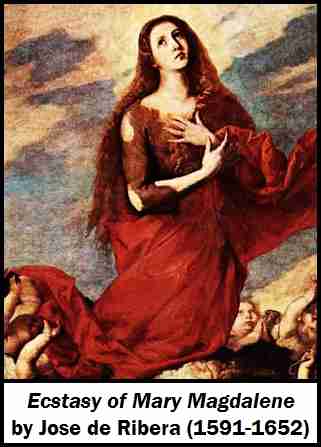
Mary Magdalene
Mary Magdalene was one of the earliest and most devoted followers of Jesus. She was among the few who saw him die on the cross, and she may have been the first person to see him alive after his resurrection.
She is also known as Mary Magdalen and Mary Magdala. The surname suggests that she came from Magdala, a city on the western shore of the Sea of Galilee. She may have become a follower of Jesus when he taught in that area during the early part of his ministry.
In the gospel story she is first mentioned in Luke 8:2-3, which says that she had been cured of seven demons. Because this passage comes immediately after the description of a "sinner" who anointed Jesus' feet (Luke 7:36-50), some later writers identified both women as the same person, and concluded that Mary had once been a prostitute. This idea has persisted into modern times, even though there is no specific evidence to support it.
Another common idea, popularized by various books and movies, is that Mary was the mysterious Beloved Disciple, and that she secretly married Jesus and bore him a child. But most biblical scholars doubt that any of this is true.
Actually, the gospels say very little about her until the story reaches the day of the crucifixion. But then she suddenly becomes very prominent. She saw Jesus die on the cross, and she watched to see where his body was taken. She went back to the tomb early on Easter morning and discovered that it was empty. And the Gospel of John indicates that she was the first person to see Jesus after his resurrection.
But then, without any explanation, she completely disappears from the story. The Book of Acts never mentions her, nor does Paul in any of his letters. Her sudden entry and exit during the most critical part of the story puzzles many people. Since she played such a big role in the key events, why is she hardly mentioned anywhere else in the New Testament?
Evidence from outside the bible suggests a possible answer. This evidence indicates that Mary was ostracized by the other disciples after Jesus departed. One example of the possible hostility toward her can be found in Section 114 of the Gospel of Thomas, where Peter says "Let Mary leave us, for women are not worthy of the Life". The Gospel of Mary (described below) also depicts friction between her and Peter. All of this suggests that Peter may have led an attempt to drive her out of the original group of believers. These first believers, who became known as the Nazarenes, lived in Jerusalem for a number of years after Jesus left, but there is no record that Mary was ever with them.
Some scholars have suggested that Peter wanted to get rid of her because he saw her as a threat to his position as the main leader of the post-resurrection community. She could have also suffered from the general prejudice against women who asserted themselves in the male-dominated societies of ancient times.
Although the bible says nothing about her later life, other sources do preserve some stories about her. According to one well-known tradition, she went to southern France and lived for thirty years at a place called La Sainte-Baume. A local church there claims to have her skull and displays it to pilgrims.
During the Middle Ages she became a symbol of the virtue of repentance, due to the belief that she was a reformed harlot. She is the patron saint of Magdalen College, Oxford and Magdalene College, Cambridge. But her name was also used for the infamous Magdalen Asylums for "fallen women" in Ireland.
The Gospel of Mary
Three fragments of a previously-lost "Gospel of Mary" have been discovered in modern times. The longest fragment, a Coptic translation from the original Greek, begins in the middle of the story and also has a large gap at a later point. But enough survives to make it clear that the "Mary" in the story is Mary Magdalene, although she is always just called "Mary" in the extant text. Actually, most scholars doubt that she was the real author, but the work could be based on some early traditions about her.
The surviving fragments depict a controversy between Mary and the other disciples, especially Andrew and Peter. Shortly after the point where the surviving text begins, the male disciples become fearful because Jesus has left them. When they begin to weep, Mary comforts and encourages them. Then she says that Jesus appeared to her in a vision and gave her some special revelations. There is a gap in the surviving text at this point, but after it resumes, Andrew and Peter begin arguing with her about the meaning of Jesus' teachings. Levi (Matthew) tries to defend Mary, but the gospel appears to end with the controversy still unresolved. Whoever wrote this gospel may have been trying to give Mary's side of a historical disagreement between her and Peter.
Note: Some scholars think that Mary's prominence in the early traditions was an obstacle to later attempts to exclude women from leadership positions in the church, and that the story of her previous life as a prostitute was a later fabrication created to discredit her.
Other Topics
Note: For more information about this disciple, go to:
-- Life of Mary Magdalene
Contact Email



